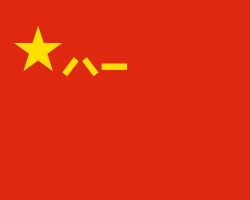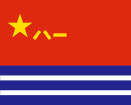Flag of the People's Republic of China
 |
|
| Name | Wǔ Xīng Hóng Qí ("Five-Starred Red Flag") |
| Use | Civil and state flag and ensign. |
| Proportion | 2:3 |
| Adopted | September 27, 1949 |
| Design | A large yellow star to the left of an arc of 4 smaller yellow stars, in the canton of a red flag. |
| Designed by | Zeng Liansong |
 |
|
| Use | War flag. |
| Proportion | 4:5 |
| Design | As above, with the arc of stars replaced by a subscript reading "eight one". |
 |
|
| Use | Naval ensign. |
| Proportion | 4:5 |
| Design | As above, with 5 horizontal stripes alternating blue and white at the bottom. |
The flag of the People's Republic of China, the "Five-Starred Red Flag (simplified Chinese: 五星红旗; traditional Chinese: 五星紅旗; pinyin: wǔ xīng hóng qí), was designed by Zeng Liansong, an economist and artist from Rui'an (瑞安 ruì ān), Zhejiang. He designed it in response to a circular distributed by the Chinese People's Political Consultative Conference (CPPCC) in July 1949, shortly after they came to power. Out of more than 3,000 entries received for the design competition, Zeng's was chosen after being nominated as one of the 38 finalists. Mao Zedong hoisted the first flag on a pole overlooking Tiananmen Square on the day of its unveiling. China's first national flag originated in 1872. It was yellow with a blue dragon, representing the Manchu (Qing) Dynasty, which ruled China for many years. The revolt of 1911 saw the changing of the flag to 5 different colored stripes. Soviet republics were established in the 1920s, each of which was represented by a red flag referring to the Soviet fatherland. The present flag dates from 1949, when the People's Republic was formed.
Contents |
History of the design
The design went through several changes and was finally approved by the Chinese People's Political Consultative Conference on September 27, 1949 at their First Plenary Session. The original design plans contained several alterations in comparison with the modern-day flag.
Three of the original flag candidates showed the large golden star (with no additional stars anywhere else) along with one, two, or three yellow bars (horizontal) at the bottom of the flag, representing the Yangtze, Huang He (Yellow River) and the Zhujiang River (Pearl River). They were not chosen by the officials, however, because the very presence of these bars appeared to suggest the idea of a tearing or splitting of the nation.
The final design was red with a large yellow five-pointed star and four smaller yellow five-pointed stars (arranged in a vertical arc toward the middle of the flag) in the upper hoist-side corner. The color red symbolizes the spirit of the revolution, and the five stars signify the unity of the people of China under the leadership of the Chinese Communist Party. The flag was officially unveiled in Beijing’s Tiananmen Square on October 1, 1949, the formal announcement of the founding of the People’s Republic of China.
Symbolism
The current design uses red as its background and bright yellow for its stars. The red background symbolizes the blood of heroes who died during the revolution. The yellow colour mainly symbolizes the glorious history and culture of the Chinese people and was partly inherited from the colours of the flag of Soviet Union, which was also a combination of red and yellow, in which case the yellow symbolizes the brightness of the communist future.
The larger star symbolizes the leadership of the Communist Party of China and the four smaller stars that surround the big star symbolize the four classes of Chinese that were considered unitable by Mao at that historical time (from one of Mao's work: On The People's Democratic Dictatorship); these are the Workers, Peasants, Petty Bourgeoisie (i.e. Small Business Class), and National Bourgeoisie (i.e. Chinese non-governmental businessmen). The most popular modern interpretation is the four stars represent the four occupations most esteemed by the Communist Party of China, which are farmers, workers, teachers, and soldiers. An interpretation under a more historical context is the four stars represent the traditional four categories of the people in the state, which are Workers (gōng, 工), Farmers (nóng, 农), Intellectual (shì, 士), and Businessmen (shāng, 商) (see also Four occupations). The one important point to note here is that the biggest star represents the Chinese Communist Party which is claimed as the leader of all.
It is sometimes stated that the five stars of the flag represent the five largest ethnic groups.[1][2] This is generally regarded as an erroneous conflation with the "Five Races Under One Union" flag, used 1912–28 in the early Republic of China, whose different-colored stripes represented the Han, Manchus, Mongols, Hui/Uyghurs, and Tibetans.[1][3]
Alternative designs
Two other designs featuring the large star with four smaller stars were also discussed. One of them showed four stars in a vertical line below the large golden star. This was rejected due to fears that it would suggest class incompatibilities and struggles. The other flag was very much the current-day PRC flag, but had the hammer and sickle in red, inside the largest golden star. The Communist icon was removed because the PRC would be a Maoist leadership, not a complete mirror of a Communist state, unlike Russia. The hammer and sickle in the flag, were it to survive, would also further complicate relations with the other four stars it represented (two smaller stars already represented the workers and the farmers; if the hammer (workers) and the sickle (farmers) were added once again to the flag, there could well be class inequalities and too similar to the flag of Soviet Union).
The usage of the flag is governed by the Law of the National Flag of the People's Republic of China. It is often raised to the music of the "March of the Volunteers," the national anthem. The Constitution of the People's Republic of China defines the flag in Article 136.

See also
- List of Chinese flags
- Emblem of the People's Republic of China
- Flag of the Republic of China
- Flag of the Soviet Union
- Red Flag
- Flags of the PRC's Special Administrative Regions:
- Flag of Hong Kong
- Flag of Macau
References
- ↑ 1.0 1.1 Shambaugh, David (June 1994). "Book reviews". The China Quarterly (CUP for SOAS) (No. 138): pp. 517–520.
- ↑ Mayall, James (1998). "Nationalism". The Columbia History of the 20th Century. ed. Richard W. Bulliet. Columbia University Press. pp. p.186. ISBN 0231076282.
- ↑ Zarrow, Peter Gue (2005). "Revolution and Civil War". China in War and Revolution, 1895-1949. Routledge. pp. p.363. ISBN 0415364485.
External links
- China at Flags of the World
- Official specifications and standard sizes of the flag.
|
|||||||||||
|
||||||||
|
||||||||||||||||||||||||||||||||||||||||||||||||||||||||||||||||||||||||||||||